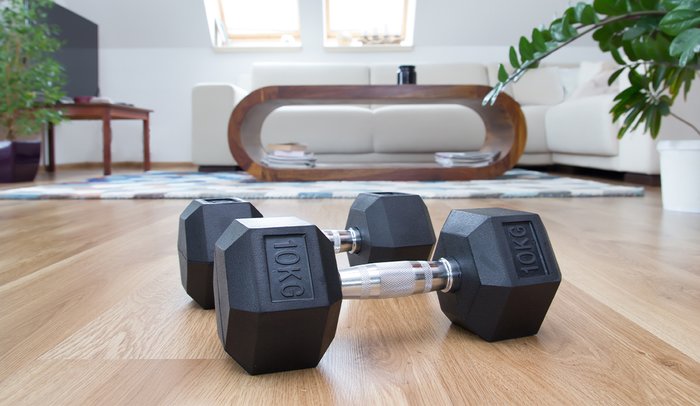Main | Training | Nutrition | Supplements | Day 1
What is the training style in this program?
The workouts in this program are performed as two four-exercise circuits with a 1-minute cardio interval in between each round. Circuit-style training is ideal for burning extra calories while still building and strengthening muscles, and each workout includes new exercises to add variety so you can stay motivated to train at home or in the gym.
The equipment required for these workouts is minimal. All you need for the entire program is a pair of dumbbells, a single kettlebell, an exercise band or two, and a bench. If you are missing any of these things, don't worry; you can mix and match the exercises in each circuit based on what you have available.
How should I warm up for my workouts?
A dynamic full-body warm-up is ideal to prepare your muscles for each resistance workout, and each workout includes 5 minutes of calisthenics you can perform anywhere.
If you already have another warm-up that you know works for you, feel free to do it. You can also just spend 5-10 minutes increasing your core body temperature by walking or jogging in place.
How heavy should I lift?
The amount of weight you lift for any exercise will always vary based on your current strength and fitness level, but most workouts will give you guidelines for how heavy you need to go based on the prescribed sets and reps of the workout.
For example, if you are asked to perform 12-15 reps in a set, you would ideally select a weight that you believe you can only lift 12 times before reaching muscle failure. If you can't reach 12, the weight is too heavy and you'll need to lighten it if possible. If you can lift the weight you chose for more than 15 reps, then you know it's too light and you need to add more weight.
If you don't have a wide selection of weights available to you, however, then you can adjust your sets, reps, or tempo instead of adjusting the weight. For example, if your weights are too light for a particular exercise, add more sets, more reps, or slow down the tempo. If your weights are too heavy, decrease the sets and reps, or get rid of the weight entirely and just perform the exercise with body weight instead.

What if I want to do extra sets?
The circuits in this program are written to be performed for 3 rounds, but if you've got more in the tank, sure, add a fourth round. Just keep a towel nearby!
What techniques do I need to know?
- Circuit: A series of three or more exercises performed back to back with little to no rest in between.
- Interval training: Training built around short, high-intensity bursts of effort performed without rest for a specified time period.
Any group of exercises can be turned into a circuit, and any one exercise can be done for an interval. For example, performing squats for 1 minute without rest is an example of how you can turn a strength exercise into an interval training exercise.
Can I do extra cardio?
Sure, you can perform cardio sessions on your off days in between resistance workouts. You can also do extra cardio after your strength workouts if you have time and want to add extra cardio training to your weekly schedule. Since you'll be getting your HIIT (high-intensity interval training) cardio in these workouts, keep your other cardio moderate intensity, such as 20-40 minutes at a level where you can still carry on a conversation.
Pick whatever type of cardio you most enjoy, whether it's walking, running, biking, jumping rope, or stair climbing, or any combination of cardio to help fill the time.
What do I do on rest days?
As mentioned above, you have the choice to add cardio training to your rest days, but if you feel like the workouts are more than enough, then use your rest days to rest.
The time that you don't spend working out on these days can be put to good use prepping meals, trying out a new healthy recipe, doing some light stretching, or just allowing your body to rest and recover. There's more to losing weight than just working out, so give your body what it needs to be successful and make your rest days count!
How do I deal with muscle soreness?
Muscle soreness is perfectly normal, especially in the first few weeks of a new program. This program is designed to give you some freedom when it comes to scheduling your workouts and how much you do, so it's imperative that you listen to your body to see if you're doing enough—or maybe too much.
If you feel like your aches and pains aren't going away or are getting worse, dial back the sets and reps or cut back on cardio. Finding the right balance takes time, so pay attention to what your body tells you and adjust as needed.
Main | Training | Nutrition | Supplements | Day 1

